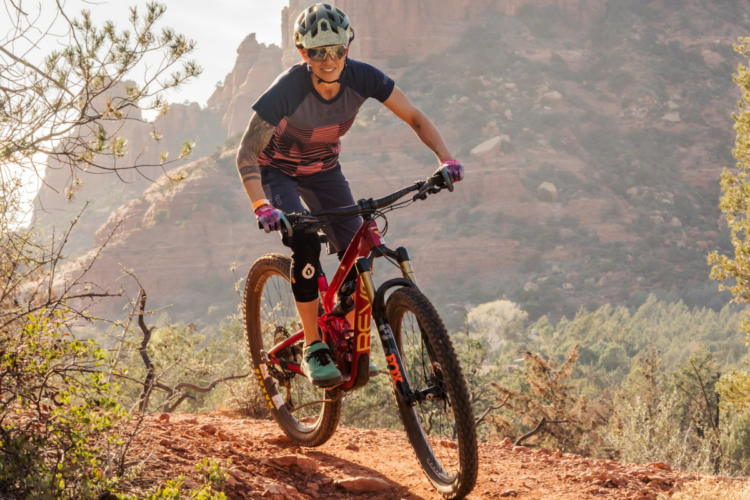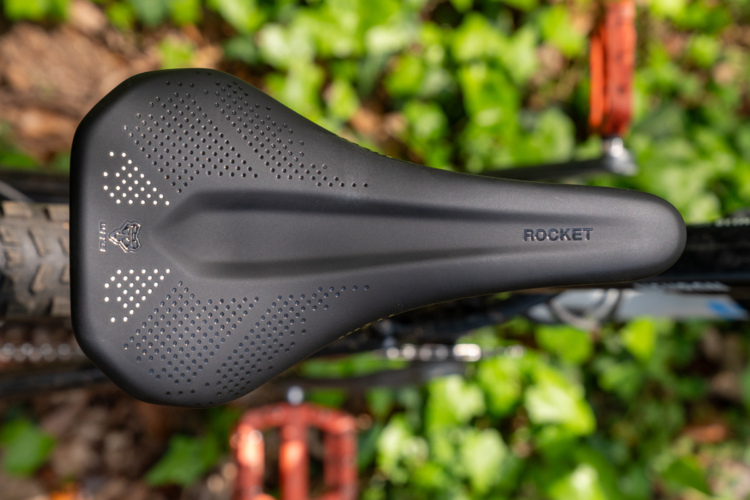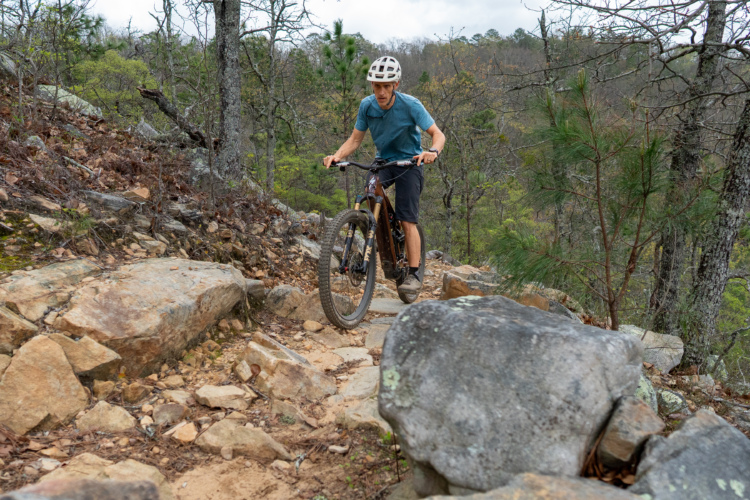
When it comes to musical albums and mountain bikes, the sophomore release is often the best. For Nirvana it was Nevermind, and for Revel it’s likely the V2 Rascal. I’ve been testing the updated Revel Rascal trail bike for several weeks now and I have to say, I’m a big fan of how it climbs and descends. If and when Revel decides to go to V3, they’ll have a hard time matching this one.


What’s new
Revel made a number of tweaks to the Rascal frame this time around to improve performance, drop weight, add features, and update the geometry. Alone, none of the changes seem huge but I’m certain they all add up to something big.
For starters the Revel Rascal V2 frame is said to be 20% more laterally stiff than the previous version, which the brand chalks up to a new carbon layup. The Rascal also sees larger pivot bearings and axles which surely helps too. The upshot to improved lateral stiffness is not only a bike that corners more predictably and pedals more efficiently but also potentially reduces the need for service and maintenance down the line.
Revel Rascal V2 key specs
- Test bike: Revel Rascal V2 size XL, SRAM XO Eagle Transmission build
- Suspension travel: 140/130mm front/rear
- Weight: 31.7lb as tested
- Price: Frame + shock starting at $3,599. Completes from $5,999. $7,999 as tested.
- Buy from Worldwide Cyclery
Revel dropped 150g off the weight of the V2 frame compared to Rascal V1, bringing the claimed weight of a size medium carbon frame (without shock) to 2,810g. One hundred and fifty grams represents about a 5% frame weight reduction which is notable, though it’s unlikely riders will notice when it comes to the complete bike.

On the feature front, the latest Revel Rascal is now UDH compatible, and the brand is making three different SRAM Eagle Transmission builds available. There’s also a new debris guard just above the bottom bracket to protect the pivot points, no doubt in answer to this frequently asked question on the Revel Rascal product page: Do you make debris guards for the Rascal? (Previously, the answer was no.)

Updated Revel Rascal geometry
Mountain bike geometry continues to progress and while the Revel Rascal V2 sees some changes, they’re pretty moderate. The brand has added a size XXL bike this time around, designed for riders 6’3″ to 6’8″ tall.
The biggest change to the geometry is the effective seat tube angle which goes steeper by a degree or more depending on the size. The XL and new XXL frame sizes have steeper seat tube angles than the smaller sizes, with the XL I tested measuring 76.5° (effective).
Reaches have grown longer for all sizes this go around, though not by a lot. While the reach on the XL is now 9mm longer than before, the length is still just under 500mm and miles away from the extreme end of current trail bike geometry.
The new 65.5° head tube angle is little changed, and few if any V1 riders will notice the difference. The chainstays are a little longer, the bottom bracket a little higher. The wheelbase, standover and stack height all increased.
Revel Rascal V1 vs V2
| Revel Rascal (size XL) | V1 | V2 | Change |
|---|---|---|---|
| Effective top tube length | 660mm | 650mm | 🔻 10mm |
| Seat tube length | 475mm | 475mm | – |
| Effective seat tube angle | 75° | 76.5° | 🔺 1.5° |
| Chain stay length | 433mm | 436mm | 🔺 3mm |
| Bottom bracket drop | 33mm | 34.2mm | 🔺 1.2mm |
| Bottom bracket height | 342mm | 345mm | 🔺 3mm |
| Head tube angle | 66° | 65.5° | 🔻 0.5° |
| Wheel base | 1233mm | 1256mm | 🔺 23mm |
| Head tube length | 127mm | 129mm | 🔺 2mm |
| Axle to crown | 551mm | 551mm | – |
| Fork offset | 44mm | 44mm | – |
| Trail | 120mm | 123mm | 🔺 3mm |
| Stack | 628mm | 635mm | 🔺 7mm |
| Reach | 489mm | 498mm | 🔺 9mm |
| Standover | 736mm | 742mm | 🔺 6mm |
One thing that stands out about all these changes is they seem to favor taller riders over shorter ones. If you were barely able to fit the standover on the small before, there’s a chance V2 won’t fit you at all. At 6’3″ tall I could probably ride an XL or XXL based on the size chart; based on my testing, I would say the XL was the right call. The XL bike felt big enough, and fit better than most any XL bike I’ve tested, which in general feel too small.


More frame features
The Revel Rascal V2 features guided internal routing that promises to make component installs much easier. While I didn’t swap any cables during my test I did notice just how quiet the bike is on the trail. Of course having a wireless derailleur on this build makes the internal routing slightly less important to buyers than it may have been in the past.
While the last Revel Rascal included an integrated chain guide, my test bike did not ship with one. I reached out to a brand representative to see if the V2 Rascal frame includes a guide but did not hear back as of press time.
Like a lot of bikes the Revel Rascal arrives with some pretty robust frame protection in place. The chainstay slap protector is beefy without being overbuilt. There’s also a generous strip of protection that runs from the underside of the bottom bracket and up the downtube a few inches. After testing the Rascal for several weeks I noticed the rubber protector has started to peel off and dirt is starting to accumulate. On a carbon bike this can be a vulnerable spot for rock hits so if I owned this bike I would probably re-glue the rubber strip with a more permanent adhesive, resale be damned.



There are two bolts that help attach the downtube protector to the frame and I found these rusted significantly in a very short period of time. The bottle mount bolts are starting to rust too, though not quite as badly. Since the shock mount bolts are titanium, it would be nice to upgrade these bolts too so they don’t rust.
The plum-colored frame I tested has a glossy sparkle finish that looks black in low light and comes alive in the sunlight. The bottom third of the frame has a matte layer over the finish that looks as if the entire frame was dipped into a translucent clearcoat. I love the look and easy maintenance of a glossy finish, but it does tend to show scratches more than a matte finish. Combining the two is a win, and putting the matte finish lower on the bike is definitely right and practical choice.

On the trail
I sent this chat message to Singletracks Managing Editor Matt Miller after my first ride on the Revel Rascal V2:
Me: I rode the Rascal last night. Probably one of the best first rides I’ve had on a test bike. Feels super lightweight and climbs well and also feels dialed on the descents right out of the gate.
Matt: Oh nice! Yeah it’s a great bike. It got me hooked on CBF.
This was my first test on a bike with Canfield Balance Formula (CBF) suspension and after several weeks of testing I have to say it works really, really well. Descending on the trail, the suspension feels responsive and is eager to get right into the meat of its travel, which I found to be excellent for fast and technical trail rides. I wouldn’t go so far as to call the suspension bottomless; this is, after all a trail bike with just 130mm of travel. However it does feel extremely capable, whether you’re getting the bike off the ground or smashing rock gardens at moderate to high speeds.
Reviewer profile height: 190cm (6’3″) weight: 75kg (165lb) testing zone: Southeast, USA
More than anything the Revel Rascal stays pinned on descents, tracking the ground confidently and with a high degree of precision. Braking ahead of corners the bike rarely sputters or gets bogged down, allowing me to track perfect lines and make fast exits. It’s the rare bike that makes me an objectively better rider.

With a moderate chainstay length and overall wheelbase the Revel Rascal feels comfortable enough on tight, technical trails. This is one of the few stock builds I’ve tested that ships with a 200mm+ dropper post which makes a huge difference in handling on the steepest slopes. The Rascal has proven equally at home on both slower, techy descents and more open, flowy trails.
Share your Revel Rascal review
Pedaling and climbing performance
From my first ride the efficiency of the Revel Rascal was apparent. “Whoa, that new bike is fast,” a friend remarked as we started the ride. The Rascal rewards aggressive, hard pedaling, transferring power from the legs to the wheels virtually one to one. The lightweight Revel RW30 wheels accelerate quickly without feeling harsh or skittish on rough singletrack.
The Rascal climbs just as well as it pedals on the flats. The nearly 32lb weight is pretty unremarkable, especially given the cost of the build I tested, but in the bike’s defense, it feels lighter than the number on the scale. I suspect the CBF suspension, known for its efficiency and traction, paired with the lightweight and responsive wheels, allows the Rascal to hug the ground without feeling bound to it as it wafts its way up the hill.
Just about the only thing that bothers me about the Rascal is its name; Rascal just seems far too cutesy for such a high performance bike. While not exactly high performance in the racing sense, it’s a bike that’s incredibly well put together and honed to do one thing well, and that is to ride trails up and down, whether it’s for a quick after work ride or all day long.



Build kit notes
For $7,999 I expect a no-compromise mountain bike build and the Revel Rascal X01 build delivers with a SRAM Transmission wireless drivetrain, RockShox Lyrik Ultimate fork, RockShox Super Deluxe Ultimate shock, SRAM Code RSC 4-piston brakes with 180mm rotors front and rear, and Revel RW30 Fusion Fiber wheels. The cockpit features Trail One carbon bars, a Trail One stem and a Wolf Tooth ReMote dropper remote. The build also includes a Continental Kryptotal tire up front, a Continental Xynotal tire in the rear, and an SDG Radar saddle.
The included Bike Yoke Revive is a favorite dropper post and I found it worked flawlessly during my testing with a quick return speed and smooth action. The XL bike I tested came with the 213mm travel Revive which made for comfortable descents and excellent handling.


Revel RW30 wheels
The Fusion Fiber rims on the Revel RW30 wheels are known for delivering an excellent ride feel and I have to agree that they hit the sweet spot. The RW30 wheels aren’t overly stiff, nor are they flexy. I never really thought about how much noise mountain bike wheels make on the trail, but Revel says these are quiet. It’s hard to say without putting them head to head with another set but given how incredibly silent the Rascal proved overall I’ll give them the benefit of the doubt.
The lightweight and efficient RW30 wheels certainly enhance the Rascal’s ability to climb and accelerate from a stop. They seem to soak up bigger hits on descents better than most wheels too without a lot of harsh feedback.
While the wheels are Revel brand, I certainly wouldn’t lump them in with other OEM parts like the mediocre Revel-branded grips. No, these are an upgrade worthy of any bike, Revel or not. Ironically when the RW30 decal is upside down in the wheel’s rotation it appears to spell out OEM.
Pros and cons of the Revel Rascal V2
Pros
- CBF suspension climbs and descends efficiently with minimal compromise
- Sensible geometry that’s both comfortable and progressive
- High quality build
- Stealthy quiet
Cons
- V2 geometry changes could put the bike out of reach for some of the smallest riders
- Frame protection bolts and glue fail quickly
Bottom line
Revel calls the Rascal the “ultimate trail bike,” and I think that’s an apt description. The Revel Rascal can handle almost any descent yet it still climbs like an XC bike, and does so with confident style.





















5 Comments
Mar 2, 2024
Mar 2, 2024
Mar 7, 2024
May 20, 2024
Mar 2, 2024
One thing I disagree on though is that I think Rascal is an awesome name,